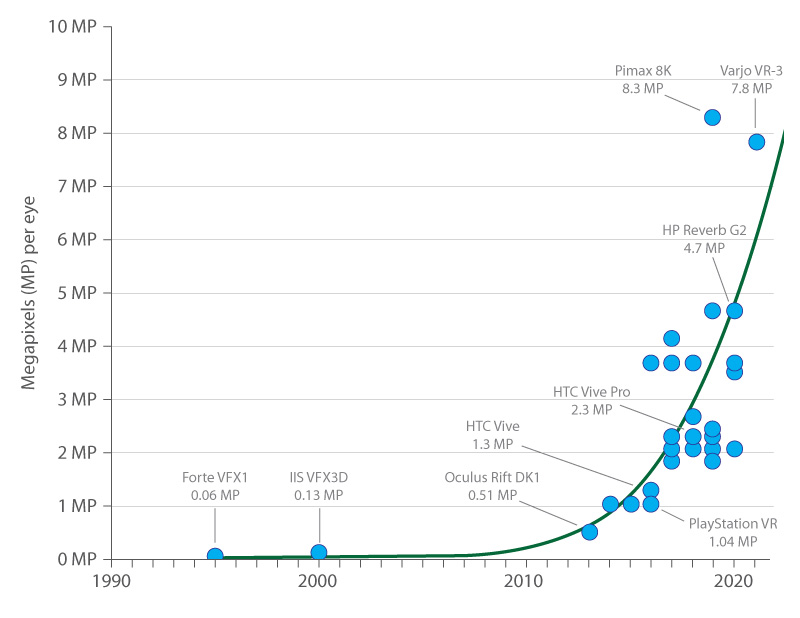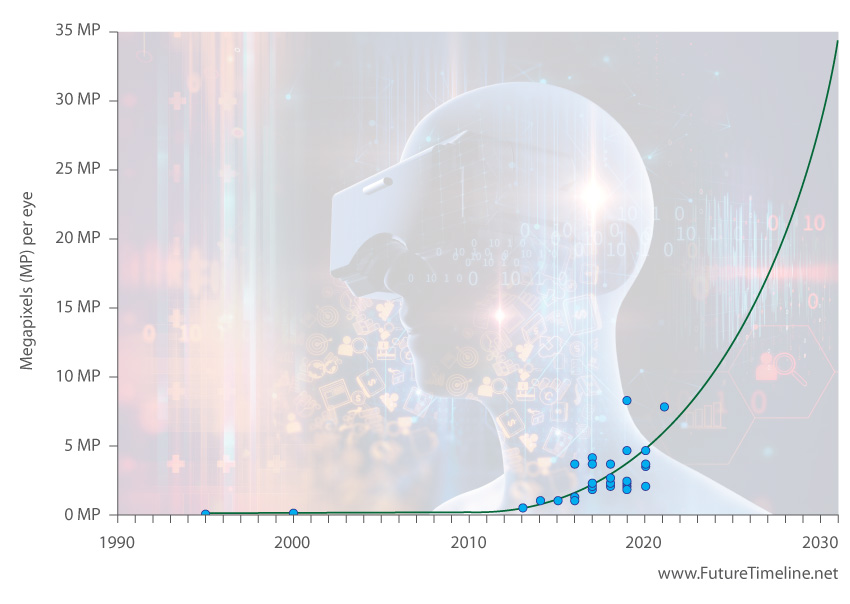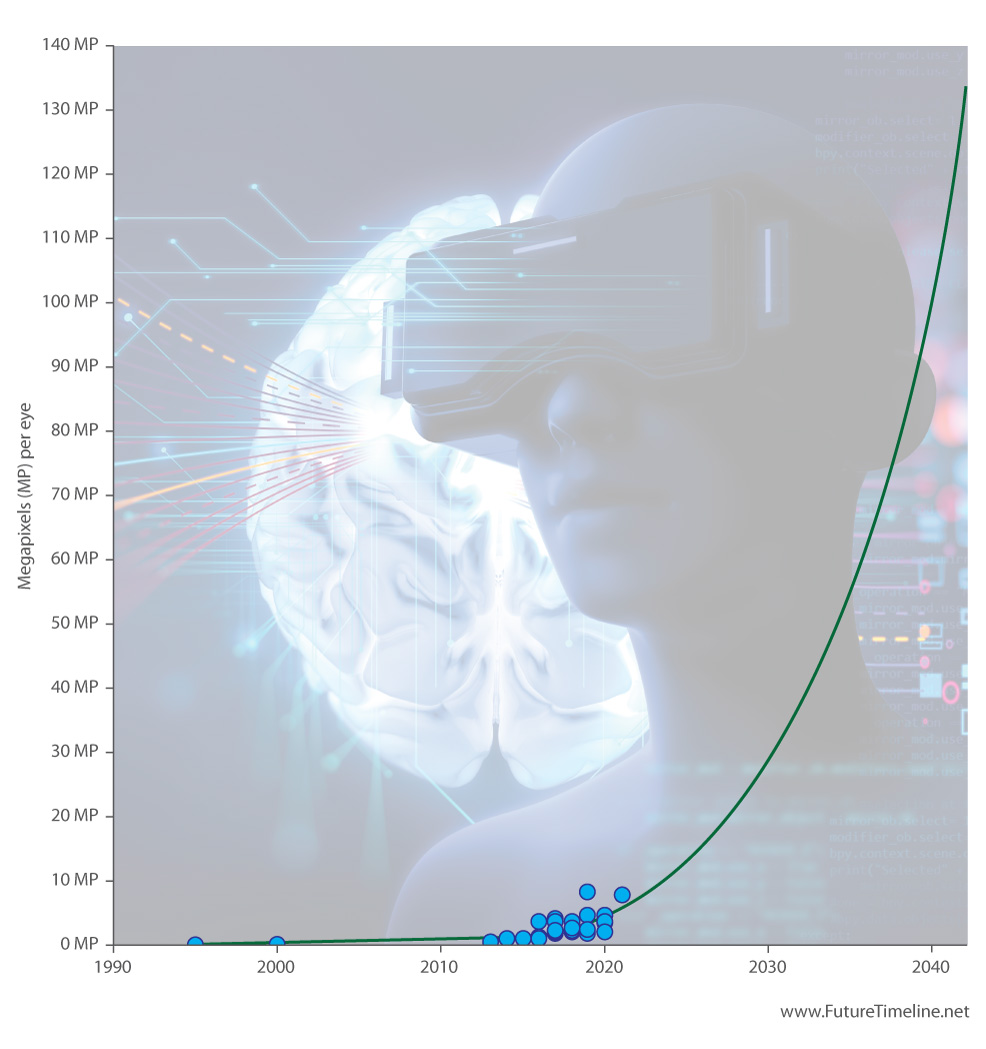
Virtual reality – future trends The quality of virtual reality (VR) headsets has improved exponentially since the 1990s. These graphs illustrate how the rapid improvement is likely to continue in the coming decades, with graphical resolutions practically indistinguishable from real life by 2040. Early concepts of alternative realities presented to a viewer had emerged as far back as the 19th century. However, it was not until the late 20th century that head-mounted display systems began to see practical and widespread use. Philosopher and computer scientist Jaron Lanier popularised the term "virtual reality" in the 1980s, and the first consumer headsets emerged in the 1990s. The 2000s were a period of relative public and investment indifference to commercially available VR technologies. However, VR staged a comeback from around 2015 to 2019. Early prototypes of the Oculus Rift, undoubtedly a major catalyst for this revival, led to competing headsets with higher pixel densities and larger fields of view (FOV), as well as lower costs. These improvements have continued into the 2020s. Today, 4K of resolution providing about eight megapixels (MP) per eye is state of the art. Only two headsets have achieved this – the Varjo VR-3 and the Pimax 8K (the latter, while describing itself as "8K", is actually 4K per eye).
Due to COVID-19 restrictions, the use of virtual reality has risen sharply since 2020, especially in the education sector. This trend appears set to continue for the foreseeable future. According to Grand View Research, the global VR market will have a compound annual growth rate (CAGR) of 18% between 2021 and 2028, more than tripling in size to almost $70 billion. Virtual reality – like many forms of information technology – seems to be following a trend somewhat like Moore's Law. So then, what might we expect as it develops over subsequent decades? If the current rate of improvement continues on its current trend, shown by the green line, we can assume graphical improvements will enable 8K displays (amounting to 33.2 MP of resolution per eye) to be a standard VR feature by 2030.
Alongside this, devices will feature larger and larger fields of view (FOV) and lower latencies (the delay between a user's head movement, and the change of display on the VR screen). The emergence of 6G will provide a further boost to VR in terms of bandwidth and connectivity. VR might evolve to offer a range of new form factors, perhaps shrinking down to the size of glasses, or even contact lenses, along with options for brain-computer interfaces. In this third and final graph, we can see the true power of exponential growth when continued over decades. A technology with just 0.06 MP of resolution in 1995 has improved by a factor of 2,250 by 2040. If the trend line is maintained, that means 16K displays (132.7 MP per eye) will be common. This transformation in graphical power, combined with audio, tactile, and other sensory improvements, will enable profound experiences to be had in VR. According to Raja Koduri, Chief Architect and Senior Vice President of Intel's graphics division, VR with 16K at 240Hz would enable "true immersion" that is practically indistinguishable from the real world. Michael Abrash, Chief Scientist at Oculus, has likewise stated that 16K display resolution is the point at which the human eye would be unable to tell the difference between virtual reality and real reality. Furthermore, while most of today's headsets provide a FOV of around 100 to 150°, the standard FOV in 2040 will likely be the full 220° experienced by humans in real life. New applications will emerge with stunning detail and realism, especially when combined with artificial intelligence. Historical re-enactments could allow a user to interact with lifelike recreations of famous people, for example, and observe key events from the past. Although VR is unlikely to fully replace travel, it will provide the ability to see, hear, and experience another city or country, akin to a very advanced form of Google Street View. Beyond 2040, how might VR develop? With display qualities largely perfected by then, attention may have turned to improving the full sensory experience of virtual reality, in ways that make a user forget they are even wearing a device, and instead feel actually "there" in a game or simulation. This would likely require integrating the body's brain and nervous system with a computer – either wirelessly or via implants, or a combination of the two – in order to establish a direct, bidirectional link with all five senses. The aforementioned brain-computer interfaces, already demonstrated in prior decades, will have improved exponentially and may offer users the chance to experience "full-immersion virtual reality" (FIVR). In the much more distant future, VR may ultimately evolve into holodeck-style environments. This would enable users to touch and interact with perfect 3D recreations of physical matter, obviating the need for any body or brain implants. Users might spend a large proportion of their lives in these virtual worlds.
Sources: Comparison of virtual reality headsets, Wikipedia: VRcompare - The Internet's Largest VR Headset Database, VRcompare: AMD's graphics boss says VR needs 16K at 240Hz for 'true immersion', TweakTown: Abrash: VR Needs to Hit 16K to Match 'Retinal Resolution', VRFocus:
Posted: 28th March 2021. Last updated: 28th March 2021.
If you enjoy our content, please consider sharing it:
|









